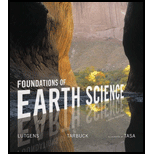
(a)
The atmospheric conditions that would precede a wildfire.
(a)
Answer to Problem 1GST
A severe drought condition and high temperature of an area that causes the draining out of moisture from the vegetation and soil, could serve as a favorable setting for a wildfire.
Explanation of Solution
Wildfires may be defined as the unrestrained fires, driven by wind, weather, and dry conditions. Wildfires can burn an extensive area. An area hit by a severe drought, exposes the region to a prolonged dry period, during which the entire vegetation and soil of the region would become free of moisture (due to existing high temperature).
This can pave way for a wildfire. However, every wildfire would be ignited by a heat source that might include lightning, campfires, hot winds or cigarettes. If the area is dry and the bushes are devoid of moisture, fire tend to spread quickly, burning much of the affected area.
(b)
The reason behind the ignition of the blaze, stating a natural and a human possibility.
(b)
Answer to Problem 1GST
A probable natural source behind a wildfire ignition could be lightning, whereas the human sources could be an abandoned campfire or cigarette.
Explanation of Solution
When a region is affected by a drought and high temperature conditions, it causes vegetation in the region to lose all its water content. The region would become extremely dry.
In such a situation, a lightning or hot wind can ignite a wildfire in the region. Humans can also initiate the ignition by dropping a burning cigarette over the dry bushes. A campfire that was abandoned without putting off, can also serve as a human induced cause of wildfire ignition.
(c)
At least one way in which wildfires might affect the future mass-wasting processes.
(c)
Answer to Problem 1GST
The precipitation following a wildfire would trigger a mass wasting process, as the fire burns the vegetation from the slope and bakes the top layer of the soil, making it dry and loose, which is a form easy to be carried downslope by any geological agent.
Explanation of Solution
Wildfires destruct the affected area very badly. Wildfires can burn an extensive area of vegetation in the affected area. Loss of vegetation from the area implies a loss to the soil. Soil without vegetation will be very fragile. The soil becomes loose, as it loses the anchoring roots of the plants and big trees that bounded the soil particles firmly together in place, in order to protect them the soil from erosion.
In addition, the baking of the ground by the fire causes the soil to become desiccated and loose, producing a water impermeable layer at a shallow depth. Such a layer acts as an impediment which would prevent or decelerate the water infiltration, thereby making the soil prone to runoff at the time of heavy showers. Most of the forest fires would be followed by heavy precipitation. Consequently, when heavy showers take place after a wildfire (that would make the top layer of the soil loose, dry and devoid of vegetation), the rich topsoil in that region would runoff, initiating mass wasting.
Want to see more full solutions like this?
Chapter 3 Solutions
Foundations of Earth Science (8th Edition)
 Applications and Investigations in Earth Science ...Earth ScienceISBN:9780134746241Author:Edward J. Tarbuck, Frederick K. Lutgens, Dennis G. TasaPublisher:PEARSON
Applications and Investigations in Earth Science ...Earth ScienceISBN:9780134746241Author:Edward J. Tarbuck, Frederick K. Lutgens, Dennis G. TasaPublisher:PEARSON Exercises for Weather & Climate (9th Edition)Earth ScienceISBN:9780134041360Author:Greg CarbonePublisher:PEARSON
Exercises for Weather & Climate (9th Edition)Earth ScienceISBN:9780134041360Author:Greg CarbonePublisher:PEARSON Environmental ScienceEarth ScienceISBN:9781260153125Author:William P Cunningham Prof., Mary Ann Cunningham ProfessorPublisher:McGraw-Hill Education
Environmental ScienceEarth ScienceISBN:9781260153125Author:William P Cunningham Prof., Mary Ann Cunningham ProfessorPublisher:McGraw-Hill Education Earth Science (15th Edition)Earth ScienceISBN:9780134543536Author:Edward J. Tarbuck, Frederick K. Lutgens, Dennis G. TasaPublisher:PEARSON
Earth Science (15th Edition)Earth ScienceISBN:9780134543536Author:Edward J. Tarbuck, Frederick K. Lutgens, Dennis G. TasaPublisher:PEARSON Environmental Science (MindTap Course List)Earth ScienceISBN:9781337569613Author:G. Tyler Miller, Scott SpoolmanPublisher:Cengage Learning
Environmental Science (MindTap Course List)Earth ScienceISBN:9781337569613Author:G. Tyler Miller, Scott SpoolmanPublisher:Cengage Learning Physical GeologyEarth ScienceISBN:9781259916823Author:Plummer, Charles C., CARLSON, Diane H., Hammersley, LisaPublisher:Mcgraw-hill Education,
Physical GeologyEarth ScienceISBN:9781259916823Author:Plummer, Charles C., CARLSON, Diane H., Hammersley, LisaPublisher:Mcgraw-hill Education,





